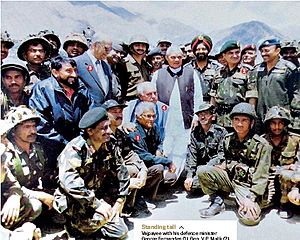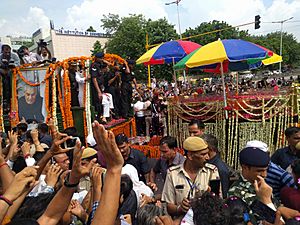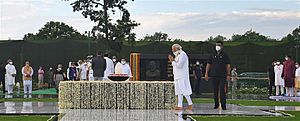Atal Bihari Vajpayee facts for kids
Quick facts for kids
Atal Bihari Vajpayee
|
|||||||||||||||||||||||||||||||||||||||||||||||||||||||
|---|---|---|---|---|---|---|---|---|---|---|---|---|---|---|---|---|---|---|---|---|---|---|---|---|---|---|---|---|---|---|---|---|---|---|---|---|---|---|---|---|---|---|---|---|---|---|---|---|---|---|---|---|---|---|---|
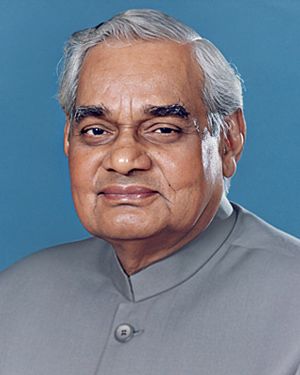
Official portrait c. 1999
|
|||||||||||||||||||||||||||||||||||||||||||||||||||||||
| 10th Prime Minister of India | |||||||||||||||||||||||||||||||||||||||||||||||||||||||
| In office 19 March 1998 – 22 May 2004 |
|||||||||||||||||||||||||||||||||||||||||||||||||||||||
| President | |||||||||||||||||||||||||||||||||||||||||||||||||||||||
| Deputy | L. K. Advani (starting in 2002) | ||||||||||||||||||||||||||||||||||||||||||||||||||||||
| Preceded by | Inder Kumar Gujral | ||||||||||||||||||||||||||||||||||||||||||||||||||||||
| Succeeded by | Manmohan Singh | ||||||||||||||||||||||||||||||||||||||||||||||||||||||
| In office 16 May 1996 – 1 June 1996 |
|||||||||||||||||||||||||||||||||||||||||||||||||||||||
| President | Shankar Dayal Sharma | ||||||||||||||||||||||||||||||||||||||||||||||||||||||
| Vice President | K. R. Narayanan | ||||||||||||||||||||||||||||||||||||||||||||||||||||||
| Preceded by | P. V. Narasimha Rao | ||||||||||||||||||||||||||||||||||||||||||||||||||||||
| Succeeded by | H. D. Deve Gowda | ||||||||||||||||||||||||||||||||||||||||||||||||||||||
| Minister of External Affairs | |||||||||||||||||||||||||||||||||||||||||||||||||||||||
| In office 26 March 1977 – 28 July 1979 |
|||||||||||||||||||||||||||||||||||||||||||||||||||||||
| Prime Minister | Morarji Desai | ||||||||||||||||||||||||||||||||||||||||||||||||||||||
| Preceded by | Yashwantrao Chavan | ||||||||||||||||||||||||||||||||||||||||||||||||||||||
| Succeeded by | Shyam Nandan Prasad Mishra | ||||||||||||||||||||||||||||||||||||||||||||||||||||||
|
|||||||||||||||||||||||||||||||||||||||||||||||||||||||
|
|||||||||||||||||||||||||||||||||||||||||||||||||||||||
| Personal details | |||||||||||||||||||||||||||||||||||||||||||||||||||||||
| Born | 25 December 1924 Gwalior, Gwalior State, British India (present-day Madhya Pradesh, India) |
||||||||||||||||||||||||||||||||||||||||||||||||||||||
| Died | 16 August 2018 (aged 93) New Delhi, Delhi, India |
||||||||||||||||||||||||||||||||||||||||||||||||||||||
| Monuments | Sadaiv Atal | ||||||||||||||||||||||||||||||||||||||||||||||||||||||
| Political party | |||||||||||||||||||||||||||||||||||||||||||||||||||||||
| Other political affiliations |
|
||||||||||||||||||||||||||||||||||||||||||||||||||||||
| Alma mater | |||||||||||||||||||||||||||||||||||||||||||||||||||||||
| Occupation |
|
||||||||||||||||||||||||||||||||||||||||||||||||||||||
| Awards |
|
||||||||||||||||||||||||||||||||||||||||||||||||||||||
| Signature | |||||||||||||||||||||||||||||||||||||||||||||||||||||||
| a. | |||||||||||||||||||||||||||||||||||||||||||||||||||||||
Atal Bihari Vajpayee (born 25 December 1924 – died 16 August 2018) was a very important Indian politician. He served as the Prime Minister of India three times. First, for 13 days in 1996, then for 13 months from 1998 to 1999, and finally for a full term from 1999 to 2004.
Vajpayee was one of the people who helped start the Bharatiya Janata Party (BJP). He was also a member of the Rashtriya Swayamsevak Sangh, a volunteer group. He was the first Prime Minister from a party other than the Indian National Congress to complete a full term. He was also a well-known poet and writer.
He was a member of the Parliament of India for over 50 years. He was elected ten times to the Lok Sabha (the lower house) and twice to the Rajya Sabha (the upper house). He represented Lucknow as a Member of Parliament. He stopped being active in politics in 2009 due to health reasons.
Vajpayee helped found the Bharatiya Jana Sangh (BJS) and was its president from 1968 to 1972. The BJS later joined other parties to form the Janata Party. This party won the 1977 general election. In March 1977, Vajpayee became the Minister of External Affairs (Foreign Minister) in Prime Minister Morarji Desai's government. He resigned in 1979, and the Janata alliance soon broke apart. Former BJS members then formed the BJP in 1980, and Vajpayee became its first president.
During his time as Prime Minister, India conducted nuclear tests in 1998, known as Pokhran-II. Vajpayee also tried to improve relations with Pakistan. He traveled to Lahore by bus to meet with Prime Minister Nawaz Sharif. After the Kargil War in 1999, he worked to restore peace by inviting President Pervez Musharraf to India for a meeting in Agra.
In 2014, the government led by Narendra Modi announced that Vajpayee's birthday, December 25, would be celebrated as Good Governance Day. In 2015, he received India's highest civilian award, the Bharat Ratna, from President Pranab Mukherjee. He passed away in 2018 due to age-related health issues.
Contents
- Early Life and Education
- Early Connection with Hindu Groups
- Early Political Career (1947–1975)
- Janata Party and the BJP (1975–1995)
- Terms as Prime Minister (1996–2004)
- 2004 General Election
- After Being Prime Minister
- Positions Held
- Personal Life
- Death
- Honours
- Awards
- Published Works
- Legacy
- See Also
- Images for kids
Early Life and Education
Vajpayee was born on 25 December 1924 in Gwalior, Madhya Pradesh. His family was Hindu. His mother was Krishna Devi, and his father, Krishna Bihari Vajpayee, was a school teacher. His grandfather had moved to Morena from their family village of Bateshwar, Uttar Pradesh.
Vajpayee went to Saraswati Shishu Mandir in Gwalior for his early schooling. In 1934, he joined the Anglo-Vernacular Middle (AVM) School in Badnagar. He later studied at Victoria College in Gwalior, which is now Maharani Laxmi Bai Govt. College of Excellence. He earned a Bachelor of Arts degree in Hindi, English, and Sanskrit. He then completed his Master of Arts degree in political science from DAV College, Kanpur.
Early Connection with Hindu Groups
Vajpayee's activism began in Gwalior with Arya Kumar Sabha, the youth group of the Arya Samaj movement. He became its general secretary in 1944. In 1939, he also joined the Rashtriya Swayamsevak Sangh (RSS) as a swayamsevak (volunteer). He became a full-time worker (pracharak) for the RSS in 1947.
He stopped studying law because of the partition events. He started working for newspapers like Rashtradharma and Panchjanya. In August 1942, during the Quit India Movement, Vajpayee and his brother were arrested for 24 days. He was released after stating he was part of the crowd but did not take part in violent acts.
Early Political Career (1947–1975)
In 1951, the RSS asked Vajpayee to work for the new Bharatiya Jana Sangh party. This party was connected to the RSS. He became a national secretary for the party in Delhi. He became a close helper of the party leader, Syama Prasad Mukherjee.
In the 1957 Indian general election, Vajpayee ran for elections to the Lok Sabha. He lost in Mathura but was elected from Balrampur. In the Lok Sabha, his speaking skills impressed Prime Minister Jawaharlal Nehru. Nehru even predicted that Vajpayee would one day become the Prime Minister of India.
Vajpayee was known for his excellent speaking skills. After the death of Deendayal Upadhyaya, Vajpayee became the leader of the Jana Sangh. He was the national president of the Jana Sangh from 1968, working with other important leaders like L. K. Advani.
Janata Party and the BJP (1975–1995)
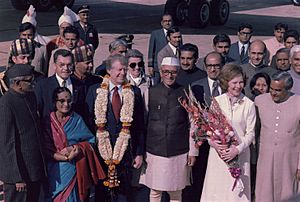
Vajpayee was arrested with other opposition leaders during the Emergency declared by Prime Minister Indira Gandhi in 1975. He was later moved to a hospital due to health reasons.
When the Emergency ended in 1977, several parties, including the BJS, formed the Janata Party. This party won the 1977 general elections. Morarji Desai became the Prime Minister, and Vajpayee served as the Foreign Minister. In 1977, Vajpayee became the first person to give a speech in Hindi at the United Nations General Assembly.
In 1979, Desai and Vajpayee resigned, and the Janata Party broke apart. Former members of the Bharatiya Jana Sangh then formed the Bharatiya Janata Party (BJP) in 1980. Vajpayee became its first President.
In the 1984 elections, Vajpayee lost his seat in Gwalior. Under Vajpayee, the BJP tried to soften its Hindu-nationalist stance. However, the BJP only won two seats in Parliament in 1984. Vajpayee offered to resign as party president but stayed until 1986. He was elected to the Rajya Sabha in 1986.
In 1986, L. K. Advani became the BJP president. Under him, the BJP returned to a stronger Hindu nationalist approach. The party became a strong voice for the Ram Janmabhoomi movement. This movement aimed to build a temple for the Hindu deity Rama in Ayodhya, where a 16th-century mosque, the Babri Mosque, stood. This strategy helped the BJP win 86 seats in the 1989 general election. In December 1992, the mosque was torn down by religious volunteers.
Vajpayee served as a Member of Parliament for many years. He represented Balrampur (1957–1962, 1967–1971), Gwalior (1971–1977), New Delhi (1977–1984), and Lucknow (1991–2009).
Terms as Prime Minister (1996–2004)
First Term: May 1996
In November 1995, BJP President Advani announced that Vajpayee would be the party's candidate for Prime Minister. The BJP became the largest party in Parliament in the 1996 Indian general election. President Shankar Dayal Sharma invited Vajpayee to form the government. Vajpayee became the 10th Prime Minister of India. However, the BJP could not get enough support from other parties to form a majority government. Vajpayee resigned after just 16 days.
Second Term: 1998–1999
After two other governments failed, new elections were held in 1998. The 1998 Indian general election again made the BJP the leading party. Many political parties joined the BJP to form the National Democratic Alliance (NDA). Vajpayee was sworn in as Prime Minister again. This was a challenging coalition because most parties did not share the BJP's Hindu-nationalist ideas. Vajpayee was praised for managing this diverse group. His government lasted 13 months. In mid-1999, the Anna Dravida Munnetra Kazhagam (AIADMK) party withdrew its support. The government lost a vote of confidence by just one vote on 17 April 1999. Since no other party could form a government, new elections were called.
Nuclear Tests
In May 1998, India conducted five underground nuclear tests in the Pokhran desert. This happened 24 years after its first nuclear test in 1974. Two weeks later, Pakistan also conducted its own nuclear tests. This made both nations openly nuclear-capable. Some countries, like France, supported India's right to nuclear power for defense. However, others, including the United States, Canada, Japan, and Britain, placed restrictions on India. Despite international criticism, the nuclear tests were popular within India. The international restrictions were lifted after only six months.
Lahore Summit
In late 1998 and early 1999, Vajpayee started a major peace effort with Pakistan. In February 1999, he began a new peace process by starting the Delhi-Lahore bus service. This aimed to solve the Kashmir dispute and other issues with Pakistan. The Lahore Declaration was signed, promising dialogue, more trade, and friendship. It also aimed for a nuclear-free South Asia. This helped reduce tensions caused by the 1998 nuclear tests.
Kargil War
In May 1999, some Kashmiri shepherds found militants and Pakistani soldiers in the Kashmir Valley. They had taken control of border hilltops and unmanned posts near the town of Kargil. The Indian army launched Operation Vijay on 26 May 1999. The Indian military fought thousands of militants and soldiers in very difficult conditions, including heavy shelling, extreme cold, snow, and tough terrain. Over 500 Indian soldiers died in the three-month-long Kargil War. India pushed back the Pakistani forces and recaptured almost 70% of the territory. Vajpayee sent a "secret letter" to U.S. President Bill Clinton, stating that India would remove the infiltrators "one way or the other." This meant he was ready to cross the Line of Control (LoC) if needed.
After Pakistan suffered heavy losses, and with the U.S. and China not supporting their actions, Pakistan's Prime Minister Nawaz Sharif asked the remaining militants to withdraw. The militants eventually left or were defeated by the Indian army.
Third Term: 1999–2004
The 1999 Indian general election happened after the Kargil operations. The BJP-led NDA won 303 out of 543 seats in the Lok Sabha, giving them a strong majority. On 13 October 1999, Vajpayee became Prime Minister of India for the third time.
In December 1999, Indian Airlines flight IC 814 was hijacked by five terrorists. The plane was flown to Afghanistan. The hijackers demanded the release of certain terrorists from prison. The government eventually agreed to their demands.
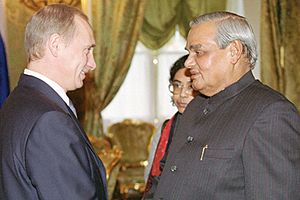
In March 2000, Bill Clinton, the President of the United States, visited India. This was the first visit by a U.S. president in 22 years. Clinton's visit was seen as a big step in improving relations between the two countries. Vajpayee and Clinton discussed many topics, leading to more trade and economic ties. They also signed a document about the future of India-U.S. relations.
At home, the BJP-led government faced challenges. It could not easily push for some of its goals, like building the Ram Janmabhoomi temple, because it needed support from other parties in the coalition. However, the BJP was accused of trying to change the official education system to reflect its Hindu nationalist views.
Vajpayee's health was also a concern, and he had knee surgery. In March 2001, a video showed some BJP members and army officers accepting bribes. This led to the resignation of Defence Minister George Fernandes.
Vajpayee invited Pakistani President Pervez Musharraf to Agra for a meeting. Musharraf was seen as the main planner of the Kargil War. By inviting him, Vajpayee showed a willingness to move forward. However, the meeting failed to achieve a major breakthrough because Musharraf did not want to set aside the issue of Kashmir.
2001 Attack on Parliament
On 13 December 2001, armed men attacked Parliament House in Delhi. They killed several security guards, but security forces quickly stopped them. The attackers were later found to be Pakistani nationals. Vajpayee ordered Indian troops to prepare for war, and hundreds of thousands of soldiers were moved to the border with Pakistan. Pakistan also moved its troops. The threat of war between the two nuclear-capable countries was very high. International leaders worked to calm the situation. In October 2002, both India and Pakistan announced they would withdraw their troops.
The Vajpayee government passed the Prevention of Terrorism Act, 2002 in 2002. This law aimed to fight terrorism by giving government authorities more power to investigate suspects.
Another challenge came between December 2001 and March 2002. A religious group, the VHP, wanted to perform a ceremony at the disputed Ram Janmabhoomi site in Ayodhya. Thousands of activists gathered, threatening to take over the site. This created a risk of violence. However, the situation ended peacefully with a symbolic handover of a stone at a different location.
2002–2004
In late 2002 and 2003, the government introduced economic reforms. India's economy grew by over 7% each year from 2003 to 2007. More foreign investment, better infrastructure, job creation, and a growing IT industry improved India's image worldwide. Good harvests and industrial growth also helped the economy.
In May 2003, Vajpayee announced he would make one last effort for peace with Pakistan. This ended a 16-month period when India had cut off diplomatic ties with Pakistan. Although relations did not immediately improve, officials exchanged visits, and the military standoff ended. Leaders from around the world praised this initiative. In July 2003, Prime Minister Vajpayee visited China. He recognized Tibet as part of China, and China later recognized Sikkim as part of India. Relations between China and India improved greatly after this.
Key Policies
Vajpayee's government introduced many economic and infrastructure reforms. These included encouraging private businesses and foreign investments. They also worked to reduce government waste and privatize some government-owned companies. Two important projects were the National Highways Development Project and the Pradhan Mantri Gram Sadak Yojana, which focused on building roads. In 2001, the government launched the Sarva Shiksha Abhiyan campaign to improve education in schools.
2004 General Election
In 2003, there were reports of disagreements within the BJP about leadership between Vajpayee and Deputy Prime Minister LK Advani. The BJP president suggested Advani should lead the party for the 2004 elections. However, when Vajpayee hinted at retirement, the party clarified that both leaders would lead.
The NDA was expected to win the 2004 Indian general election. They called elections six months early, hoping to benefit from economic growth and Vajpayee's peace efforts with Pakistan. The BJP used the "India Shining" campaign to highlight the nation's economic progress.
However, the BJP only won 138 seats out of 543 in Parliament. Many important cabinet ministers lost their seats. The NDA coalition won 185 seats. The Indian National Congress, led by Sonia Gandhi, became the largest single party with 145 seats. The Congress and its allies formed the United Progressive Alliance (UPA), which had 220 seats. Vajpayee resigned as Prime Minister. The UPA, with support from other parties, formed the next government with Manmohan Singh as Prime Minister.
After Being Prime Minister
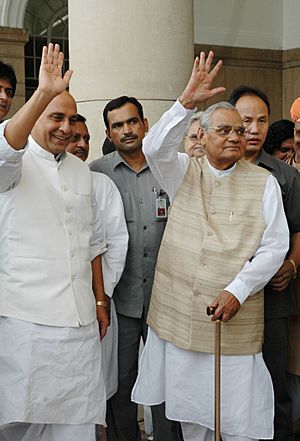
In December 2005, Vajpayee announced he was retiring from active politics. He said he would not run in the next general election. At a BJP rally, he stated that L. K. Advani and Pramod Mahajan would be the new leaders, like the brothers Rama and Lakshmana from the Hindu epic.
Former Prime Minister Manmohan Singh called Vajpayee the Bhishma Pitamah of Indian politics. This refers to a respected character in the Hindu epic Mahabharata.
In February 2009, Vajpayee was hospitalized for a chest infection. His health worsened, and he needed ventilator support, but he recovered. Due to poor health, he could not campaign for the 2009 Indian general election. However, he wrote a letter asking voters to support the BJP. His close associate Lalji Tandon won the Lucknow seat in that election.
Positions Held
| Year | Position | Place | Party | Remark |
|---|---|---|---|---|
| 1951 | Founding-Member | Bharatiya Jana Sangh | Bharatiya Jana Sangh | |
| 1957–1962 | MP, Balrampur (Lok Sabha constituency) | 2nd Lok Sabha | Bharatiya Jana Sangh | 1st Term |
| 1957–1977 | Leader | Bharatiya Jana Sangh Parliamentary Party | Bharatiya Jana Sangh | |
| 1962–1968 | MP, Uttar Pradesh, Rajya Sabha | Rajya Sabha | Bharatiya Jana Sangh | 1st Term (Resigned on 25 February 1967) Elected to Lok Sabha |
| 1966–1967 | Chairman | Committee on Government Assurances | Rajya Sabha | |
| 1967 | MP, Balrampur (Lok Sabha constituency) | 4th Lok Sabha | Bharatiya Jana Sangh | 2nd Term |
| 1967–70 | Chairman, | Public Accounts Committee | Bharatiya Jana Sangh | |
| 1968–1973 | President | Bharatiya Jana Sangh | Bharatiya Jana Sangh | |
| 1971 | MP, Gwalior (Lok Sabha constituency) | 5th Lok Sabha | Bharatiya Jana Sangh | 3rd Term |
| 1977 | MP, New Delhi (Lok Sabha constituency) | 6th Lok Sabha (4th term) | Janata Party | (4th term) |
| 1977–1979 | Union Cabinet Minister, | External Affairs | Janata Party | |
| 1977–1980 | Founding Member | Janata Party | Janata Party | |
| 1980 | MP, New Delhi (Lok Sabha constituency) | 7th Lok Sabha | Bharatiya Janata Party | (5th term) |
| 1980–1986 | President, | Bharatiya Janata Party | Bharatiya Janata Party | |
| 1980–1984, 1986 and 1993–1996 | Leader | Parliamentary Party | Bharatiya Janata Party | |
| 1986 | MP, Madhya Pradesh, Rajya Sabha | Rajya Sabha | Bharatiya Janata Party | 2nd Term |
| 1988–1989 | Member, | General Purposes Committee | Rajya Sabha | |
| 1988–1990 | Member, | House Committee
Member, Business Advisory Committee |
Rajya Sabha | |
| 1990–1991 | Chairman, | Committee on Petitions | Rajya Sabha | |
| 1991 | MP, Lucknow (Lok Sabha constituency) | 10th Lok Sabha | Bharatiya Janata Party | (6th term) |
| 1991–1993 | Chairman, | Public Accounts Committee | Lok Sabha | |
| 1993–1996 | Chairman, | Committee on External Affairs | Lok Sabha | |
| 1993–1996 | Leader of Opposition, | Lok Sabha | Bharatiya Janata Party | |
| 1996 | MP, Lucknow (Lok Sabha constituency) | 11th Lok Sabha | Bharatiya Janata Party | 7th Term |
| 16 May 1996 – 31 May 1996 | Prime Minister of India; and in charge of other subjects not allocated to any other Cabinet Minister | Bharatiya Janata Party | Bharatiya Janata Party | |
| 1996–1997 | Leader of Opposition, | Lok Sabha | Bharatiya Janata Party | |
| 1997–1998 | Chairman, | Committee on External Affairs | Lok Sabha | |
| 1998 | MP, Lucknow (Lok Sabha constituency) | 12th Lok Sabha | Bharatiya Janata Party | 8th Term |
| 1998–1999 | Prime Minister of India; Minister of External Affairs; and also incharge of Ministries/Departments not specifically allocated to the charge of any Minister | Bharatiya Janata Party | Bharatiya Janata Party | |
| 1999 | MP, Lucknow (Lok Sabha constituency) | 13th Lok Sabha | Bharatiya Janata Party | 9th Term |
| 1999 | Leader, | Parliamentary Party, Lok Sabha | Bharatiya Janata Party | |
| 13 Oct.1999- May 2004 | Prime Minister of India and also in charge of the Ministries/Departments not specifically allocated to the charge of any Minister | Bharatiya Janata Party | Bharatiya Janata Party | |
| 2004 | MP, Lucknow (Lok Sabha constituency) | 14th Lok Sabha | Bharatiya Janata Party | 10th Term |
| 2004 | Chairman, | Parliamentary Party | Bharatiya Janata Party & |
Personal Life
Vajpayee never married. He adopted and raised Namita Bhattacharya, the daughter of his longtime friend Rajkumari Kaul. His adopted family lived with him. He was a well-known poet who wrote in Hindi. His published works include Kaidi Kaviraj Ki Kundalian, a collection of poems written during the 1975–1977 Emergency. He once wrote about his poetry, "My poetry is a declaration of war... It is not the defeated soldier's drumbeat of despair, but the fighting warrior's will to win."
Death
Vajpayee had a stroke in 2009, which affected his speech. His health was a major concern; he used a wheelchair and sometimes did not recognize people. He also had dementia and diabetes. For many years, he did not attend public events and rarely left his home, except for medical checkups.
On 11 June 2018, Vajpayee was admitted to All India Institute of Medical Sciences, Delhi (AIIMS) due to a kidney infection. He was officially declared dead there at 5:05 pm IST on 16 August 2018, at the age of 93.
On the morning of 17 August, Vajpayee's body, covered with the Indian flag, was taken to the Bharatiya Janata Party headquarters. Party workers paid their respects until 1 pm. Later that afternoon, at 4 pm, Vajpayee was cremated with full state honors at Rashtriya Smriti Sthal near Raj Ghat. His adopted daughter, Namita Kaul Bhattacharya, lit his funeral pyre. Thousands of people and many important guests, including Prime Minister Narendra Modi and President Ram Nath Kovind, attended his funeral. On 19 August, his ashes were immersed in the Ganga river at Haridwar.
Reactions and Tributes
India reacted to Vajpayee's death with great sadness. Thousands of tributes were shared on social media. A seven-day period of national mourning was announced across India. The national flag flew at half-mast during this time.
Many countries and leaders also shared their condolences:
- Afghanistan: Former Afghan President Hamid Karzai attended the funeral. He remembered Vajpayee as the first leader to offer civilian planes to Afghanistan when they were starting out.
- Bangladesh: Prime Minister Sheikh Hasina expressed deep shock, calling Vajpayee "one of the most famous sons of India" and a highly respected person in Bangladesh.
- Bhutan: Bhutan's King Jigme Khesar Namgyel Wangchuck attended the funeral.
- China: China's Ministry of Foreign Affairs stated that Vajpayee was an "outstanding Indian statesman" who made great contributions to China-India relations.
- Israel: Prime Minister Benjamin Netanyahu called Vajpayee "a true friend of Israel."
- Japan: Japanese Prime Minister Shinzo Abe recalled Vajpayee's visit to Japan in 2001. He said Vajpayee made significant contributions to the friendship between the two countries.
- Mauritius: The government of Mauritius announced that both Mauritian and Indian flags would fly at half-mast. The Prime Minister of Mauritius announced that a cyber tower, which Vajpayee helped set up, would be named after him.
- Pakistan: Pakistan's interim Law and Information Minister, Syed Ali Zafar, attended the funeral. Former Pakistani President Pervez Musharraf called Vajpayee a great man and said his death was a great loss for both India and Pakistan.
- Russia: Russian President Vladimir Putin sent condolences, calling Vajpayee an "outstanding statesman." He said Vajpayee made a major personal contribution to the friendly relations between Russia and India.
- Sri Lanka: Many Sri Lankan leaders paid tribute, calling him a "friend of Sri Lanka." President Maithripala Sirisena said, "Today, we have lost a great humanist and a true friend of Sri Lanka."
- United States: U.S. Secretary of State Mike Pompeo said Vajpayee understood early on that the US-India partnership would help global prosperity and security. He recalled Vajpayee's 2000 speech where he called US-India ties a "natural partnership."
Honours
National Honours
- India:
- Bharat Ratna (2015) - India's highest civilian award
- Padma Vibhushan (1992) - India's second-highest civilian award
Foreign Honours
- Bangladesh:
- Recipient of the Bangladesh Liberation War Honour (2016)
- Morocco:
- Grand Cordon of the Order of Ouissam Alaouite (13 February 1999)
Other Achievements
- In 2012, Outlook magazine ranked Vajpayee number 9 in its poll of The Greatest Indian.
- In August 2018, Naya Raipur was renamed as Atal Nagar.
- In October 2018, four Himalayan peaks near Gangotri glacier were named after him.
Awards
- 1993, D. Lit. from Kanpur University
- 1994, Lokmanya Tilak Award
- 1994, Outstanding Parliamentarian Award
- 1994, Bharat Ratna Pandit Govind Vallabh Pant Award
Published Works
Vajpayee wrote several books of prose and poetry. Here are some of his main publications:
Prose
- National Integration (1961)
- New Dimensions of India's Foreign Policy (1979)
- Gathbandhan Ki Rajneeti
- Kucha Lekha, Kucha Bhashana (1996)
- Bindu-Bindu Vicara (1997)
- Decisive Days (1999)
- Sankalp-Kaal (1999)
- Vicara-Bindu (Hindi Edition, 2000)
- India's Perspectives on ASEAN and the Asia-Pacific Region (2003)
- Na Dainyam Na Palayanam
- Nayi Chunouti : Naya Avasar
Poetry
- Kaidi Kaviraj Ki Kundalian
- Amar Aag Hai (1994)
- Meri Ikyaavan Kavitaen (1995) (Some of these poems were set to music by Jagjit Singh for his album Samvedna.)
- Kya Khoya Kya Paya: Atal Bihari Vajapeyi, Vyaktitva Aur Kavitaem (1999)
- Values, Vision & Verses of Vajpayee: India's Man of Destiny (2001)
- Twenty-One Poems (2003)
- Chuni Hui Kavitayein (2012)
An English translation of some of Vajpayee's Hindi poetry was published in 2013.
Legacy
In 2014, the government led by Narendra Modi declared Vajpayee's birthday, 25 December, as Good Governance Day. The world's longest tunnel, Atal Tunnel at Rohtang, Himachal Pradesh, was named after Atal Bihari Vajpayee. The third longest cable-stayed bridge in India over the Mandovi River, Atal Setu, was also named in his memory. The Government of Chhattisgarh changed the name of Naya Raipur to Atal Nagar.
See Also
 In Spanish: Atal Behari Vajpayee para niños
In Spanish: Atal Behari Vajpayee para niños
- List of prime ministers of India
- List of Indian writers
Images for kids


